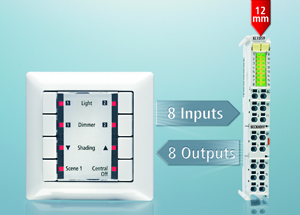Displaying items by tag: Beckhoff
Beckhoff Drive Technology: Motors in new wash-down variant
Hygiene regulations in the food industry place high demands on drive and control components with regard to surfaces and materials, which must be able to withstand regular exposure and resistance to aggressive cleaners. By coating a standard servomotor so that it is suitable for use around food products, Beckhoff breaks new ground: the white coating, which is typical in the food industry, is compliant with FDA (Food and Drug Administration) regulations and guarantees that the products manufactured with it are not in any way tainted by chemicals.
The FDA-compliant motors differ from the standard types only by their surface and by the stainless steel shaft, otherwise they are identical. The advantage for the 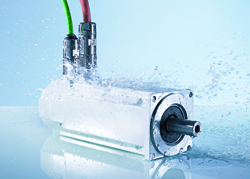 user is that additional motor types do not have to be ‘designed into’ the machine in the case of mixed use of coated and standard motors. A further advantage is the price: the coating adds only about 30 percent to the price of the standard motors, depending on the size. Not only that, the IP 67 design permits use in harsh industrial environments.
user is that additional motor types do not have to be ‘designed into’ the machine in the case of mixed use of coated and standard motors. A further advantage is the price: the coating adds only about 30 percent to the price of the standard motors, depending on the size. Not only that, the IP 67 design permits use in harsh industrial environments.
The flange sizes 2…7 from the Beckhoff AM3000 series are optionally available with the new surface coating.
Please send readers' questions regarding “Wash-down motors” to: Beckhoff Automation GmbH, Eiserstraße 5, 33415 Verl, Germany Phone: +49 (0) 5246 963-0, Fax: +49 (0) 5246 963-198 e-mail: This email address is being protected from spambots. You need JavaScript enabled to view it., Internet: www.beckhoff.de
Beckhoff EtherCAT Box: High channel density for harsh environments
The Beckhoff EtherCAT Box modules in the new 16-channel variant can be integrated directly into any EtherCAT network. The high EtherCAT performance of 100 Mbit/s is once again retained right into every IP 67 box. With an exactly double housing width of 126 x 60 x 26.5 mm (5-in x 2.4-in x 1-in), the modules offer suitable space for 16 digital inputs or outputs. The modules are fitted with M8 or M12 sockets for the signal connections. Due to the doubling of the number of channels per EtherCAT Box, the user saves time and cost, both with the EtherCAT cabling and the power cabling.
The following I/O variants are available, in each case with optional M8 or M12 screw connectors:
- EP1809: 16-channel digital input
- EP2809: 16-channel digital output
- EP2339: 16-channel digital I/O (freely configurable)
The mounting points are taken over by the compact, 30 mm (1.2-in) wide EtherCAT Box modules, so that the 16-channel box modules can be installed conveniently with the same grid spacing.
EP1809: 16-channel digital input
EP2809: 16-channel digital output
EP2339: 16-channel digital I/O (freely configurable)
Please send readers' questions regarding “16-channel EtherCAT Box” to: Beckhoff Automation GmbH, Eiserstraße 5, 33415 Verl, Germany Phone: +49 (0) 5246 963-0, Fax: +49 (0) 5246 963-198 e-mail: This email address is being protected from spambots. You need JavaScript enabled to view it., Internet: www.beckhoff.de
TwinCAT PLC library for high-precision positioning tasks
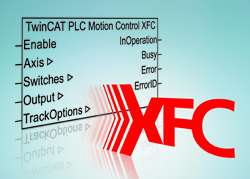 XFC technology (eXtreme Fast Control) from Beckhoff offers an extremely fast, high-precision control and regulation architecture for world class machine builders. Through short I/O response times, XFC enables increased machine and system throughput since signal delay times are significantly reduced. As a new development, XFC has been extended for motion applications with a new software library for TwinCAT automation software. The XFC library facilitates the high-precision detection of axis positions and the output of digital signals for the exact position in connection with Beckhoff EtherCAT I/O Terminals.
XFC technology (eXtreme Fast Control) from Beckhoff offers an extremely fast, high-precision control and regulation architecture for world class machine builders. Through short I/O response times, XFC enables increased machine and system throughput since signal delay times are significantly reduced. As a new development, XFC has been extended for motion applications with a new software library for TwinCAT automation software. The XFC library facilitates the high-precision detection of axis positions and the output of digital signals for the exact position in connection with Beckhoff EtherCAT I/O Terminals.
With the function blocks in the TwinCAT PLC Motion Control XFC library, the time stamps of EtherCAT Terminals can be acquired with high precision and converted into the corresponding axis positions. The EL1252 digital input terminal records fast binary control signals with a resolution of 1 nanosecond (ns). This technology permits signals to be traced exactly over time and synchronised with EtherCAT distributed clocks across the system. This allows, for example, the storage of the current position (latches) at arbitrary places in the EtherCAT system. An appropriate touch probe block according to the PLCopen standard is available in the library. Up to now, high precision latching has only been possible directly on the drive, often with only very few inputs. This can now take place locally at any point using the XFC library and the appropriate time stamp-based EtherCAT Terminals. This saves wiring and makes virtually any number of latch inputs possible.
On the other hand, it is very simple to convert axis positions into highly precise times. This allows high precision cam controllers to be realised. The time 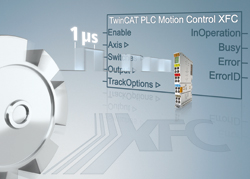 stamp-based digital outputs of the EL2252 or EL2262 EtherCAT Terminals can similarly be arranged at any point in the EtherCAT fieldbus system. A TwinCAT PLC function block according to the PLCopen standard is similarly available for cam controllers.
stamp-based digital outputs of the EL2252 or EL2262 EtherCAT Terminals can similarly be arranged at any point in the EtherCAT fieldbus system. A TwinCAT PLC function block according to the PLCopen standard is similarly available for cam controllers.
The prerequisite for the maximum attainable accuracy is the automatic dead time compensation of axes, which is available for EtherCAT and SERCOS drives from TwinCAT 2.11 onward. An exact correlation between time and position can only be achieved with dead time compensation.
TwinCAT PLC Motion Control XFC: www.beckhoff.com/TwinCAT-PLC-MC-XFC
Please send readers' questions regarding “TwinCAT XFC” to: Beckhoff Automation GmbH, Eiserstraße 5, 33415 Verl, Germany Phone: +49 (0) 5246 963-0, Fax: +49 (0) 5246 963-198 e-mail: This email address is being protected from spambots. You need JavaScript enabled to view it., Internet: www.beckhoff.de
Beckhoff Building Automation: BC9191 compact Room Controller bundles functions for single room control
Multi-system room automation is of great importance both for efficient operation of buildings and for the individual comfort of the users and, over and above that, to offer substantial savings potential. In the Beckhoff I/O system, an extensive range of over 400 Bus Terminals is available to building technicians for the connection of all building sensors and actuator systems.
The new BC9191 Room Controller closes the gap in very price-sensitive projects with firmly defined functions. By bundling certain functions in one module, the compact Room Controllers are ideally suited, for example, for installation in hotel rooms or office spaces. Rooms or areas with repetitive requirements only require one-time programming of the Room Controller, which is then simply duplicated, depending on the number.
The BC9191 can be used as a compact controller or as decentralized intelligence for room control. Pre-installed software functions facilitate commissioning. On top of that, the BC9191 can also be freely programmed using TwinCAT automation software from Beckhoff. For networking, the room controller is equipped with two Ethernet ports with integrated 2-channel switch. The I/O stations can thus be configured with a line topology, instead of the classic star topology.
In order to implement additional functions, the BC9191 Room Controller can be modularly extended with the entire range of Bus Terminals via the K-bus interface. Standard Bus Terminals and the sub-bus systems relevant for building automation, such as EnOcean, LON, EIB, DALI and M-bus, are optionally expandable.
Integrated I/O signals:
- digital inputs:
- 3 x 24 V DC (e.g. window contact, dew point, occupancy sensor)
- analog inputs:
- 3 x 0...10 V (e.g. CO2 sensor, air quality sensor, brightness sensor)
- 1 x PT/Ni1000 (-20…+60 °C) for air temperature measurement
- 1 x resistance measurement for set value specification
- digital outputs
- 1 x 230 V AC, 10 A, relay (e.g. water re-heater)
- 3 x 230 V AC, 1 A, relay (3-stage fan)
- 2 x 230 V AC, 1 A, triac (e.g. valves for heating and cooling)
- analog outputs:
- 2 x 0…10 V (e.g. volumetric air flow controller)
Please send readers' questions regarding “Room Controller” to: Beckhoff Automation GmbH, Eiserstraße 5, 33415 Verl, Germany Phone: +49 (0) 5246 963-0, Fax: +49 (0) 5246 963-198 e-mail: This email address is being protected from spambots. You need JavaScript enabled to view it., Internet: www.beckhoff.de
Beckhoff Building Automation: PC-based automation as the basis for energy-efficient buildings
In addition to building automation functions, Beckhoff PC-based control technology also offers the basic data acquisition technology for energy:
- local signal acquisition via the Bus Terminal I/O system
- data transmission via Ethernet or other bus systems
- evaluation in the Industrial PC via TwinCAT automation software
- provision of the energy data via standardized interfaces (e.g. OPC) to higher-level systems of the building and data management
The seamless integration of the energy and consumption data acquisition for all systems in the automation system results in savings potentials and synergies, both in the system installation and in the further operation of the building. The measured data are transferred to the control center via open interfaces and analyzed by the building management system. On the basis of comprehensive statistics and analysis functions, the building operator can recognize weak points and initiate targeted improvement measures. The available data pool also enables exact accounting and billing of consumption.
Energy consumption measurement via Bus Terminals
In addition to the standard terminals, the Beckhoff Bus Terminal system also offers numerous I/Os for measurement applications:
- acquisition of current consumption via the power measurement terminal (KL3403) and/or the digital multimeter terminal (KL3681)
- acquisition of water, gas and heat consumption via M-bus (KL6001/KL6021 serial interfaces with level converter)
- temperature measurement, e.g. via the KL3228 8-channel resistance measuring terminal
- pressure measurement or the detection of leaks in the compressed air supply (KM3702)
Using TwinCAT automation software, the measured data are processed further, and switching and regulating actions may be implemented immediately; alternatively, communication with the command level is established.
The energy data are made available via defined software interfaces, such as OPC, to the higher-level energy management software or the building management, where they are evaluated or analyzed. The measured data can additionally be assigned to certain cost centers, for example by connecting to an ERP system.
Using the “TwinCAT Scope 2” software oscilloscope, curves can be displayed graphically with a resolution on the order of microseconds.
Please send readers' questions regarding “Energy monitoring” to: Beckhoff Automation GmbH, Eiserstraße 5, 33415 Verl, Germany Phone: +49 (0) 5246 963-0, Fax: +49 (0) 5246 963-198 e-mail: This email address is being protected from spambots. You need JavaScript enabled to view it., Internet: www.beckhoff.de
Beckhoff Building Automation: Software solution for Ethernet-based building standard
Beckhoff integrates BACnet/IP as a pure software solution into its TwinCAT automation suite. The BACnet/IP Server and Client are executable on all Beckhoff Industrial PCs and Embedded PCs. This means that every Beckhoff Embedded PC becomes a BACnet controller with the software extension. Since the I/O level (Bus Terminals or EtherCAT Terminals) can be added directly to the modular Embedded PCs, Beckhoff’s comprehensive range of Bus Terminals with over 400 different signal types is also available for BACnet applications. In a modular system, for example, information can be queried via temperature measurement or an occupancy sensor and sent via the appropriate data output to the heating or lighting controller.
The BACnet solution for TwinCAT supports all services of a BBC device (BACnet Building Controller). The BACnet objects are created in the TwinCAT System Manager and can be parameterised and linked there. Data from an I/O terminal or from the TwinCAT program can be connected directly to a BACnet object via a cyclic interface. An acyclic interface is used for reading and writing the “properties” of a BACnet object, so that these can be accessed from the PLC program during runtime. With the aid of TwinCAT, a network can be scanned for BACnet devices and objects or “properties” can be accessed.
The market introduction of the BACnet/IP solution is expected to be in late 2010.
Please send readers' questions regarding “BACnet/IP” to: Beckhoff Automation GmbH, Eiserstraße 5, 33415 Verl, Germany Phone: +49 (0) 5246 963-0, Fax: +49 (0) 5246 963-198 e-mail: This email address is being protected from spambots. You need JavaScript enabled to view it., Internet: www.beckhoff.de
Building Automation: reducing control cabinet and assembly costs
The HD Bus Terminals are available in various versions, such as 16-channel terminals for digital inputs or outputs, 8-channel terminals for digital inputs or outputs with 2-wire connection, or “multi-tasking” combination terminals with eight digital inputs and eight digital outputs, offering the user a high degree of flexibility.
There is a broad range of applications for HD Bus Terminals in building automation: for example, 8-way buttons with integrated LEDs, for indicating the switching statuses, can be wired completely to a single 12 mm Bus Terminal. Eight thermal drives can be controlled completely by a single 12 mm output terminal using the 2-wire technique. On the input side, eight window or door contacts can be connected to one HD Bus Terminal using the 2-wire technique. With the compact I/O modules, the user saves valuable installation space in the control cabinet and the cost per channel is lowered significantly. A further advantage is the simplification of system assembly. Despite the high packing density, the convenient layout of the connection points is retained.
www.beckhoff.com/HD-Busterminal
Please send readers' questions regarding “Building HD Terminals” to: Beckhoff Automation GmbH, Eiserstraße 5, 33415 Verl, Germany Phone: +49 (0) 5246 963-0, Fax: +49 (0) 5246 963-198 e-mail: This email address is being protected from spambots. You need JavaScript enabled to view it., Internet: www.beckhoff.de

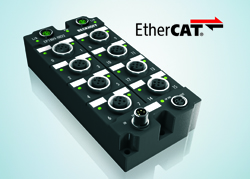 The new EtherCAT Box modules for the trusted IP 67 system from Beckhoff contain an impressive 16 channels – a notable increase over the previous 8 – in a double-width housing, significantly reducing cabling effort and the price per channel.
The new EtherCAT Box modules for the trusted IP 67 system from Beckhoff contain an impressive 16 channels – a notable increase over the previous 8 – in a double-width housing, significantly reducing cabling effort and the price per channel.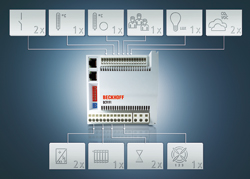 With the BC9191 Room Controller, Beckhoff is extending its range of products for building automation and closing a gap in the price-sensitive area of single room control. The compact Ethernet controller covers all standard functions for the control of single rooms. Via the integrated K-bus interface, the BC9191 can be extended modularly with Beckhoff Bus Terminal I/O, offering users the greatest possible flexibility.
With the BC9191 Room Controller, Beckhoff is extending its range of products for building automation and closing a gap in the price-sensitive area of single room control. The compact Ethernet controller covers all standard functions for the control of single rooms. Via the integrated K-bus interface, the BC9191 can be extended modularly with Beckhoff Bus Terminal I/O, offering users the greatest possible flexibility.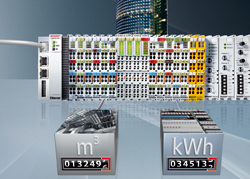 Investors and planners are faced with the challenge of coming to grips with energy costs without making cuts in the comfort of a building. The basis for this is the control and measurement of the energy consumption of individual systems. PC-based automation offers the ideal solution for the acquisition of energy and consumption data as an integral component of intelligent building automation. The energy consumption for current, water, gas or heating is recorded directly in the Beckhoff Bus Terminal system.
Investors and planners are faced with the challenge of coming to grips with energy costs without making cuts in the comfort of a building. The basis for this is the control and measurement of the energy consumption of individual systems. PC-based automation offers the ideal solution for the acquisition of energy and consumption data as an integral component of intelligent building automation. The energy consumption for current, water, gas or heating is recorded directly in the Beckhoff Bus Terminal system.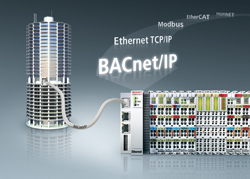 Beckhoff’s PC-based control technology for building automation primarily utilises the global standard Ethernet TCP/IP for communication from the management to the field level. In addition to further Ethernet-based communication protocols, such as Modbus TCP, PROFINET and EtherCAT, the integration of BACnet/IP adds another standard for networking different systems, thus extending the areas of application for this open control technology.
Beckhoff’s PC-based control technology for building automation primarily utilises the global standard Ethernet TCP/IP for communication from the management to the field level. In addition to further Ethernet-based communication protocols, such as Modbus TCP, PROFINET and EtherCAT, the integration of BACnet/IP adds another standard for networking different systems, thus extending the areas of application for this open control technology.